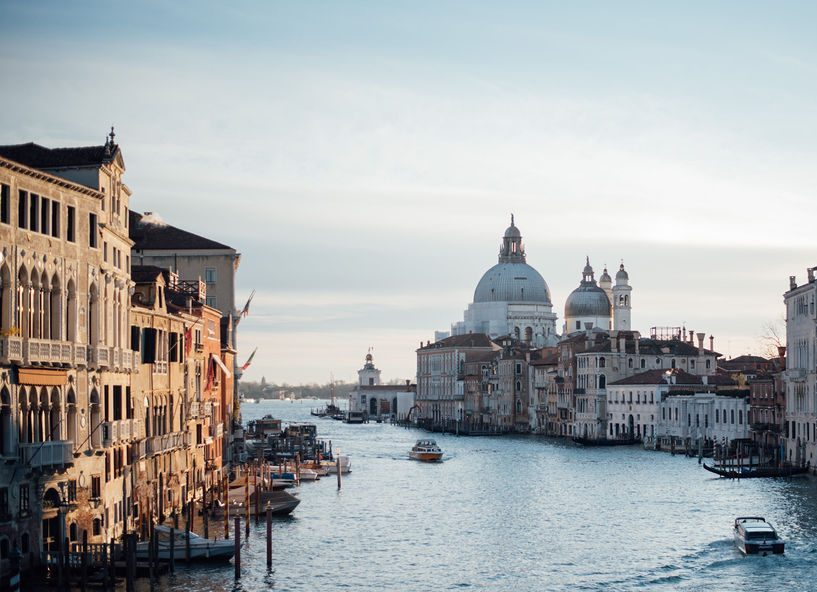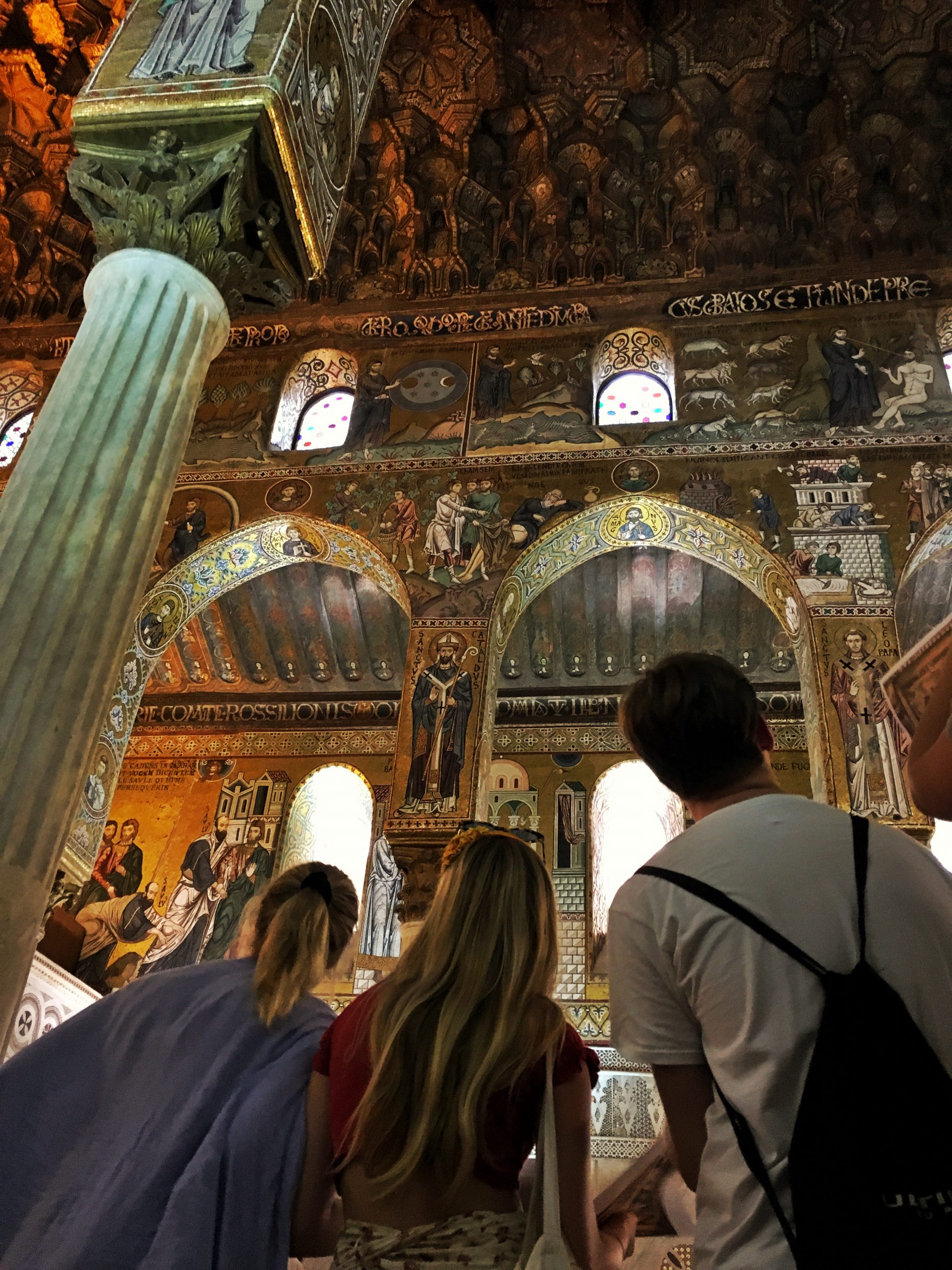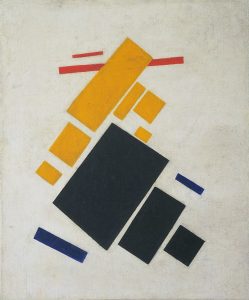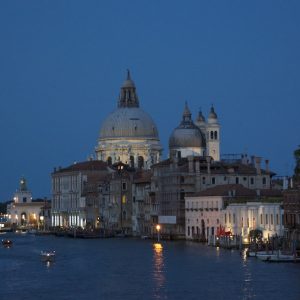-
NAPLES • REGGIO CALABRIA • AGRIGENTO • PALERMO • VENICE • ROME • FLORENCE
08 July – 05 August 2024
“… we were seeing unique works. Nowhere else could we see a Caravaggio alone […] we went snorkelling on top of submerged Roman ruins; went on a boat trip to beautiful islands and had a fantastic meal every night… I would definitely recommend.” Reggie, Southern Summer Course 2017, Cambridge University
This trip combines the Southern and Northern Italy courses into a complete 4-week journey, visiting Naples, Reggio Calabria, Agrigento, Venice, Rome, and Florence.
One of the key attractions of this course is that it offers a holistic experience of Italy, from North to South, allowing you to fully appreciate the country’s diverse landscapes and rich cultural tapestry.
We use art and architecture to explore a wide array of subjects, including history, art history, philosophy, politics, music, and literature. Our students have the opportunity to visit iconic sites, participate in artist-led workshops, and engage in various local activities, such as cooking classes and gondola rowing. This course is interactive and social, promoting a hands-on approach that goes beyond traditional classroom learning. We are committed to helping students develop a ‘habit’ of creativity, empowering them to generate new ideas and confidently express their thoughts.
Read “A day in the life of an AHA student” to get an idea of what an AHA day looks like.
‘I was feeling bored and uninspired from being stuck at home during lockdown without anything to do. I was not keen at first to go on a summer course as what I imagined was a sort of glorified school trip. I could not have been more wrong.’ – Hatty, Summer Course -
Who joins our summer programs:

- school leavers, 6th formers
- university students on their summer holidays
- students from all academic backgrounds
- students who realise that a cultured, educated mind is a mark of distinction in whatever career they pursue
- anyone who is aged between 18 and 22 from every academic discipline
- students join individually rather than in groups making friends on the program
- International pool of students
Why should you join?

- it broadens the horizons of any education
- it will open your eyes to painting, architecture, sculpture & more
- 4 weeks of Italian food, classics, wine and music in the balmy summer heat
Many students who have enjoyed our Northern Italian course choose to follow it with a Southern Italian one, either the same year as a 4-week course or coming back the following year.
Students join us because they appreciate that an enjoyment of art, architecture, sculpture and Italy is as important as an understanding of music or literature. It is a fantastic opportunity for those studying sciences to broaden their horizons.
For art historians, this course will expand beyond the usual canon of art history to give the student a great depth of understanding and visual experience. For classicists, historians, or indeed, anyone who questions the ‘need to know’ culture, this course will do much to engender a cultivated mind.
-
COMBINATION ITALY SUMMER PROGRAM:

THE FIRST 2 WEEKS
This part of the course is extraordinary. You will delve deep into the wonders of the Ancient World as well as tread the lesser known path of Caravaggio.
We run the Southern Italy course at the end of July so that those who want a 4-week course can combine it with our Northern Italy Course.
PALERMO
We begin our odyssey in Palermo which has been named Italian culture capital for 2018 and whose centre has been nominated as a world heritage site by UNESCO. Palermo lies on a magnificent line of coast, backed by looming mountains. It is a wonderful place to go swimming on a free afternoon, to eat the most delicious food and to discover the vibrant beauty of Sicily.
AGRIGENTO
SYRACUSE
We arrive late at Syracuse and dine while looking over the great harbour where the Athenian fleet crumbled and Alcibiades’ men perished as described by Thucydides himself. We stay on the ancient Isle of Ortigia and there are Greek temples, theatres, Baroque churches and Caravaggios to explore. One afternoon we will take a private boat to the Caves of the Cyclops from Odysseus.
At Porto Paolo di Menfi, we visit the Imperial Roman Villa at Casale where the exquisite mosaics are so great that it is assumed this remote villa must have been that of a retired Emperor. That night, we stay at a hotel near the beach.
NAPLES
An amazing city, full of Caravaggio’s masterpieces and reminders of the Neapolitan Baroque, when Naples was the most populous and richest city in Europe. It remains a vibrant city, also home to an excellent contemporary art collection at the Museo Madre and the greatest archaeological museum in the world with surprising, amazing and charming finds from Pompeii and Herculaneum.
THE LAST 2 WEEKS

Here you will be joined by new students who have opted for the majestic wonders of Northern Italy.
VENICE
The aquatic city is home to masterful painters such as Titian and Bellini. It is the model city for a proud, self-governed republic and with its passion for carnival and Casanova it became a city of sumptuousness, display and parties. The changing atmosphere of Venice is the highlight, sound travels mysteriously over its waters and through the canals. The light is continuously reflected making it a mecca for artists for over 500 years.
FLORENCE
Home of Michelangelo and fellow geniuses, as well as where the alarm clock was invented. This is the place to get to grips with politics, philosophy and the economics of a developing, successful city, where art and architecture both expresses and explains. The Italian literature of Dante and Bocaccio is explored amongst medieval churches and houses, whilst scenes from E.M. Forster’s’ ‘Room with a View’ can be reenacted in the Piazza Signoria and the dozens of loggias dotted around the city.
ROME
From the Forum to the Colosseum to the first legal Christian Church, Rome holds more mind-boggling moments than any other city. One look at the poetry of Byron, Shelley or Keats explains the impact that this place had on their ‘Grand Tour’. There is also, of course, the Vatican Museum where one can indulge in the ancient collection of sculpture, Raphael’s frescoes and the mighty Sistine chapel and ceiling.
-

Arguably, Italy has more significant art than any place on earth and so we study painting, architecture, sculpture, textiles, gardens, mosaics, drawings and decorative arts over the following periods:
- the Ancient World

- Romanesque
- Gothic
- the Renaissance
- the Baroque
- Classicism
- Modern and Contemporary
Within these periods we study

- painting techniques (fresco, oil, tempera, etc.)
- artists: their biographies, significances, influence and patronage
- connoisseurship and collections
- art criticism and propaganda
You will be in some of the most beautiful cities in the world
 Venice – for the Renaissance and modern art
Venice – for the Renaissance and modern art- Florence – for the Renaissance
- Rome – Ancient, Renaissance, Baroque and modern
- Palermo – for Norman Architecture and Ancient Greec
- Agrigento – for the Valley of Temples
- Syracuse – for ancient Greek masterpieces and Baroque elegance
- Reggio Calabria – for the Riace Bronzes
- Naples – Ancient Pompeii, The Baroque and modern art
Please note duration in the cities above may vary according to the course or time of year.
We break up the course with day visits to:

- Selinunte – for ancient greek temple
- Segesta – for ancient greek ruins
- Old Gibellina – for the incredible Cretto di Burri
- Pompeii or Herculaneum
- Vesuvius
The programme is very carefully designed to be both chronological and thematic in order that students can fathom large swathes of history.
We teach the context of art, so we touch on the following where relevant:

- Music
- Political theory
- Classics
- Greek and Roman mythology
- Literature
- Economics
- Philosophy
- Theology
- Poetry
- History
- Food
- Anthropology
- Environmental Studies
We build a solid foundation of the terminology of art and history:

- artistic and architectural; vocabulary & descriptive terms
- classical and biblical narrative; myths & stories
- geographical; Italy and Europe
- basic datelines, significant families, Popes, historical events
- general themes; politics, propaganda & patronage
AHA also issues our “Shortish Notes” which are an unusual compendium of maps, significant dates, lists and descriptions of mythological gods, emperors, old and new testament figures, saints, popes and leaders. The notes include architectural terms, notes on the guilds and the family trees major families. It is a much sought after document as no such item is to be found in print.
There is also time for the following extracurricular activities:
 Drawing; there is always someone to help and encourage craftsmanship
Drawing; there is always someone to help and encourage craftsmanshipMarbled paper making
Creative writing
Marble making in Florence
Italian classes in manners and comportment
Mask making in Venice
Gondola rowing lessons
Visits to concerts and the Opera and the football
Italian Language and Culture classes
Italian cooking classes
An introduction to Italian Cinema
English Romantic Poetry
I hope you will agree this course aims to make the most amazing use of your time. Quite simply, we want this to be the greatest experience and a true education.
Apply now Gallery - the Ancient World
-
Our tutors are chosen for their intellect, knowledge, energy, manners, reliability and sensibility.

‘For you as a student, the reason why a tutor is so important to you is because they are accessible. They aren’t stuffy, they’re youthful, they’re inspiring, they’re somebody to look up to and they are somebody to be conversational with’ – Nick Ross, Director of AHA
Students should drop any ideas they have about teachers versus students, as do all our tutors – this is not a “school trip”. Our brilliant tutors are dynamic, enthusiastic experts from various academic fields. They roll back the disciplines of formal education and provide an inter-disciplinary approach that includes (to name a few) philosophy, history, theology and mythology.
WHAT ARE THE TUTORS LIKE?
Illuminating, fascinating, inspiring!
Judging from thank you letters and word of mouth recommendations, we know that our tutors are a significant selling point for the course. AHA tutors are specialists, entirely approachable and have a passion for all things Italian. They are sympathetic and dedicated to encouraging the best in all students of every academic background.
Much as they wear their academic laurels lightly, they are committed to making comprehensible the artists, writers, and architects who are the real stars of the cultural galaxy.
Having brilliant tutors on the course who pitch in every evenings, travel with the students and stay in the same hotel, not only means they are on hand at all times, but also allows students to imbibe the positive wonder, happiness and satisfaction that we all get from Italy.
Students should drop any ideas they have about teachers versus students, as do all our tutors – this is not a ‘school trip’. Our tutors are dynamic, enthusiastic experts from various academic fields. They roll back the disciplines of formal education and provide an inter-disciplinary approach that includes (to name a few) philosophy, history, theology and mythology.
HOW DO SMALL TUITION GROUPS WORK?
Great teaching ratios are fundamental to on-site study and AHA’s ethos. Teaching to 9 students or fewer, tutors can reach everyone, draw them into discussion and satisfy the interests and capacities of each student.
Each day one or two tutorial groups set out in different directions to follow a theme according to the carefully structured itinerary. Tutors teach according to their specialist interests enabling students to appreciate different approaches to the subject. Usually a tutorial group would visit two or three sites in a morning with a break along the way.
Day by day students become more confident; understanding, enjoying and commenting on the vast visual world around them. Students are supplied with a suggested reading list and shorter notes, which are invaluable for the course and thereafter. We go to many places far from the madding crowd, some of which are public but are barely visited, others are by private appointment.
Before we have met any students, we form the tutorial groups by picking names from a hat. With each new major city these groups are reshuffled by this pre-ordained method. The dynamic of the party is therefore changed throughout the course and we find this a good way for students to get to know each other as we progress through Italy.
-
We understand that going through the small print can be arduous, so do apply to arrange a call with one of us.
AHA’s Nick Ross takes you through what to expect with our programmes. You can either watch the videos through or navigate to a video of your choice by clicking the top right hand corner of the video.
Useful Links
Accommodation

Our view on hotels is that it is better to stay near the middle of the wonderful cities we visit, where there is a sense of history and atmosphere. Rooms are shared with en suite bathrooms in 2’s and 3’s; occasionally we may use quadruple rooms for the shorter stays. Over the years we have built up strong relationships with family run hotels in all the cities we visit.
It’s worth calling the office to ask which hotels we are using on the course you would like to attend, but generally in Rome the hotel is next to the lively Campo dei Fiori; in Florence we stay a stone’s throw from the Duomo and in Venice we stay across the Grand Canal from St Marks.
Luggage
 You will be expected to carry your own luggage, lift it onto trains, buses, upstairs occasionally and so on. This is no idle observation; if you have a bad back, tell us about it. Most people have luggage with wheels, but be sure they are robust and up to going over cobbles. Ruck sacks are good.
You will be expected to carry your own luggage, lift it onto trains, buses, upstairs occasionally and so on. This is no idle observation; if you have a bad back, tell us about it. Most people have luggage with wheels, but be sure they are robust and up to going over cobbles. Ruck sacks are good.In the run up to your course we will send notes about what to bring but please follow the old adage that whatever you pack at first you should then halve it. Furthermore, one of the joys of travelling is to come back with trophies from your travels, whether this be clothes, books or pictures. We have had occasions when students have spent a fortune either posting luggage or spending extra fees with airlines. Both should be unnecessary.
Transport
 When we move between cities we often take the train or we hire a bus. The train is perhaps more fun, with a real sense of travel. Usually, when leaving a hotel for the station we will walk for 10 minutes or so, but if you would like a taxi, we can order one for you.
When we move between cities we often take the train or we hire a bus. The train is perhaps more fun, with a real sense of travel. Usually, when leaving a hotel for the station we will walk for 10 minutes or so, but if you would like a taxi, we can order one for you.Flights
 When you register, we will inform you of the flights we have chosen for the group for you to book direct with the airline. If you come by another route, we will do our best to meet you, but bear in mind that once in Italy, tutors have lots of responsibilities both in terms of teaching and pastorally and they might not be able to meet you off the plane. In any event, we will give you good instructions on how to find the hotel and how to meet us.
When you register, we will inform you of the flights we have chosen for the group for you to book direct with the airline. If you come by another route, we will do our best to meet you, but bear in mind that once in Italy, tutors have lots of responsibilities both in terms of teaching and pastorally and they might not be able to meet you off the plane. In any event, we will give you good instructions on how to find the hotel and how to meet us.For non UK students, some fly to the UK, which is a major hub, and then join the group to fly to Italy. If they arrive a day early, we can advise on where to stay if needs be.
Photo: Airplane Flying (Malevich, 1915)
Meals, Food & Wine
 The food in Italy is one of the great pleasures of an AHA course. At lunchtime, students are free to do as they please – it’s a great time to explore or draw, but often students and tutors will end up enjoying an inexpensive lunch or picnic together. It is a similar situation at supper; students are free to do as they please but, for almost all evenings, tutors will canvas opinion and organise something fun. This might be supper out, or a film or a concert. We feel that convivial suppers for students and tutors make a strong bond on the course and are part of Italian life. It is where conversation flows and we at AHA understand your interests and passions.
The food in Italy is one of the great pleasures of an AHA course. At lunchtime, students are free to do as they please – it’s a great time to explore or draw, but often students and tutors will end up enjoying an inexpensive lunch or picnic together. It is a similar situation at supper; students are free to do as they please but, for almost all evenings, tutors will canvas opinion and organise something fun. This might be supper out, or a film or a concert. We feel that convivial suppers for students and tutors make a strong bond on the course and are part of Italian life. It is where conversation flows and we at AHA understand your interests and passions.Eating, diet and allergies are issues raised on the Registration Form and it is really important that we know.
Those coming on Gap Year Courses are over 18 and therefore allowed to drink alcohol; however, as detailed in the Code of Conduct, we expect that this is done in moderation and drunkenness is not acceptable. Responsible consumption of alcohol is, in our view, a lifelong issue.
Breakfast is included within the fees though it has to be said that Italian hotels often perform some indescribable ritual to their coffee to render it questionable.
Mid way through the morning, it is usual to perk ourselves up with a break for a coffee and rest.
Spending Money
 Lunches and suppers are not included in the course price. We recommend that students bring £35 – £38 per day to cover these meals and spending money. Very occasionally, if a student has a problem with cash flow, tutors will lend money but for administrative reasons, we would be grateful if loans could be repaid before the end of the course.
Lunches and suppers are not included in the course price. We recommend that students bring £35 – £38 per day to cover these meals and spending money. Very occasionally, if a student has a problem with cash flow, tutors will lend money but for administrative reasons, we would be grateful if loans could be repaid before the end of the course.Money is best drawn regularly on ATMs and in modest amounts for fear of inadvertent loss. Pre-loaded travel money cards are a good solution to this issue because, if lost, they limit exposure to fraud.
Mentoring & Care
With tutor ratios of 1:9 or fewer, there are never less than 2 and up to 4 tutors on each course. This promotes excellent care for young adults. AHA tutors are instructed and mentored before they can be considered senior tutors or a lead tutor. Tutors stay in the same hotel, travel together and enjoy meals in the company of students. Tutors are there to help and offer advice. At all times tutors are supported by AHA’s offices in the UK.
A brief look at our tutors’ page reveals that we have tutors of a variety of ages. We feel it is important to have young tutors who are both a mentor and inspiration to young adults as well as more venerable tutors. New tutors to AHA are trained via our manual, through training tutorials and while on courses as a trainee tutor.
We will send you a Code of Conduct which lays out the understanding between students and AHA about reasonable standards of conduct.
Throughout the Gap Year & Semester courses there are one to one tutorials during which the academic progress of students are discussed. These are especially useful to encourage the development of students and form the basis for references in the future if requested.
Museums, Itineraries & Timetables
All museum fees and special entry costs are included and make up approximately 15% of the fees. Bookings for most of our visits are made in advance; this means less time spent queuing and reinforces the need for punctuality throughout the course.
Pre-Course Preparation
We will send you our list “Books worth reading, films worth watching” none of which is obligatory but which may enhance your experience of the course. In the weeks running up to your course, you will receive a note on what to bring as well as useful notes to accompany the course. AHA will also send you a watercolour set and drawing pad. Practical art is not compulsory on the course but we hope that these will be useful for those who already are happy to draw while being an encouragement to others.
Application & Registration
 If you’re ready to apply, just go to How to Apply page to fill in the form to begin the two-part registration process. Once we have your application, we will contact you to discuss the course further. We will want to know more about you, what are your interests and plans. Importantly, it is a chance for you to ask detailed questions of us. All being well, we will send you a link to a registration form and give you details of how to lodge a deposit.
If you’re ready to apply, just go to How to Apply page to fill in the form to begin the two-part registration process. Once we have your application, we will contact you to discuss the course further. We will want to know more about you, what are your interests and plans. Importantly, it is a chance for you to ask detailed questions of us. All being well, we will send you a link to a registration form and give you details of how to lodge a deposit.By signing the registration form and returning it with a non-refundable deposit you are bound by the terms and conditions of the course. The terms and conditions require each attendee to have paid in full prior to the course date of departure. Should you need to cancel, there are clear guidelines and terms available. Where possible, and at our sole discretion, we will transfer your place to another course if needs be, having taken account of any pre-payments or unrecoverable costs.
Insurance
AHA carries public liability insurance to a total value of £5m in case AHA should cause loss or injury to a client or student. It is also essential that students should acquire sufficient insurance to cover the fees in the event that a student needs to cancel their course at a time when all or part of the fees are due. Insurance for health is also mandatory as well as repatriation. On top of this, you should insure your possessions, particularly electronics, having noted separately the make, mark and serial numbers of any valuables. You are obliged to inform AHA of the company providing the insurance cover and the Emergency Help telephone contact number. It is your responsibility to ensure that the insurance cover you purchase is suitable and adequate for your particular needs.
Payment Schedules
 At our discretion, we may offer interest free, monthly payments for a course. Full and final payment must be in our account before the course departs. Please contact the office directly to enquire about this.
At our discretion, we may offer interest free, monthly payments for a course. Full and final payment must be in our account before the course departs. Please contact the office directly to enquire about this.Scholarships & Bursaries
See our Scholarship page for details, read our blog “How to find grants for your gap year” and call us to ask about bursaries.
Risk Assessment, Responsibility
Those joining our Gap Year Courses are over 18 and young adults and can expect to be treated as such. Adult life goes with free will and free will has an element of risk within it. However, parents and students can reasonably expect AHA courses to be safe in the provision of services and tuition. To this end, we write extensive risk assessments for all our courses and we also have a crisis management plan. We follow the standards laid down by the Year Out Group and we review all our courses through questionnaires and tutor feedback. Lastly, we have public liability insurance to a limit of £5,000,000 per any one occurrence upon which we have never had to claim.
For UK residents, check the FCO website for their current risk assessments by country. For US residents, check the Smart Travel Enrollment Program (STEP) for up to date advice and help.


